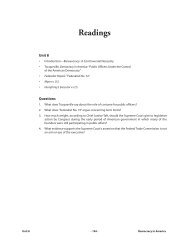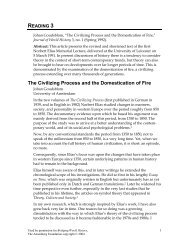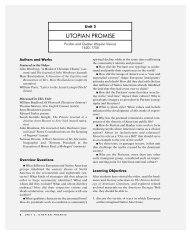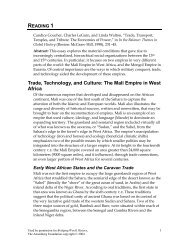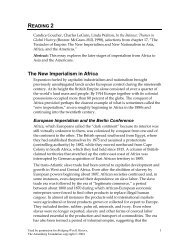Create successful ePaper yourself
Turn your PDF publications into a flip-book with our unique Google optimized e-Paper software.
Europe. Birdwood was an adamant proponent of the superiority of European<br />
individual artistic genius; he also popularized the notion that all Indian<br />
artisans created products in the second half of the nineteenth century which<br />
demonstrated the degeneration of “native” taste and craft techniques [End<br />
Page 54] resulting from European design influences (Birdwood 1880; see<br />
Ahad for Kashmiri technological innovations).<br />
Kashmiri weavers responded to information about design preferences in<br />
Europe by producing shawls in accordance with them because they were long<br />
accustomed to weaving in response to consumer preferences, not because<br />
their “authentic” traditions were overwhelmed. Kashmiri shawls were<br />
produced by highly specialized weavers; they were never meant to be a<br />
standardized product for a mass market. As Maureen Fennell Mazzaoui<br />
argues, the handicraft producers who used sophisticated technologies to<br />
weave luxury textiles made of goat hair relied on a “high level of product<br />
differentiation” to be competitive in Asian markets (1998, xli–xlv). In addition<br />
to many varieties of shawls, weavers in the 1820s produced turban lengths,<br />
blankets, sashes, “gown-pieces,” shawl carpets, trousers, netted cloth, caps,<br />
short and long stockings, curtains, saddle cloths, elephant “housing,” quilts,<br />
coverlets, cravats, neckerchiefs, belts, linings, leggings, waist strings [izarband,<br />
to hold up pajamas], pillow covers, purses, shrouds, and wall hangings. Each<br />
type of merchandise was targeted to a particular geographical location<br />
including countries (Afghanistan, colonial India, Tibet, Iran, Russia, Armenia,<br />
Turkey, Arabia) and cities (Kabul, Istanbul, Bokhara, Baghdad) that were also<br />
nodes in long-distance trading networks. At least some of the commodities<br />
described as destined for Turkistan and Yarkand traveled on to China.<br />
Weavers also produced “plain” shawl goods for “domestic use” in Kashmir<br />
(Moorcroft cited in Irwin 1973, appendix 1).<br />
The Western European gendering of employment skills as primarily either<br />
feminine or masculine intersected with racist colonial labor discourse in the<br />
representations of Kashmiri shawl weavers. Male refugars (“repairers” or<br />
“darners”) used embroidery to embellish Kashmiri shawls from at least the<br />
late sixteenth century, but it was the woven designs created through the very<br />
time-consuming, kani (woven twill tapestry) weaving technique that initially<br />
reached Europe and later impressed twentieth-century European and Euro-<br />
American connoisseurs (Chandra, 65–67). Eighteenth-century kani shawls<br />
contained a minor amount of embroidery, but several nineteenth-century<br />
production changes led to new types of shawls in which needlework became<br />
much more important. In the “patchwork” or “pieced” twill tapestry shawls,<br />
artisans joined many small woven pieces by intricate needlework (Beardsley<br />
1988). Artisans also embroidered the previously woven designs of a kani<br />
shawl onto plain-weave pashmina, creating amlkari or amli shawls. European<br />
textile historians interpreted these changes in [End Page 55] production as the<br />
Used by permission for Bridging World History, 22<br />
The Annenberg Foundation copyright © 2004



